Sustainable Mobility Matters—Spring 2024
This quarterly newsletter highlights recent projects, partnerships, and publications related to NREL's sustainable mobility research.
Subscribe to receive this newsletter via email.
The Signs of the Electric Vehicle Transition Are All Around Us
I just got back from a road trip to Texas to see the solar eclipse. As I drove south, I didn't just see the signs of winter turning into spring—I also saw all kinds of exciting signs of the transition to electric vehicles (EVs).
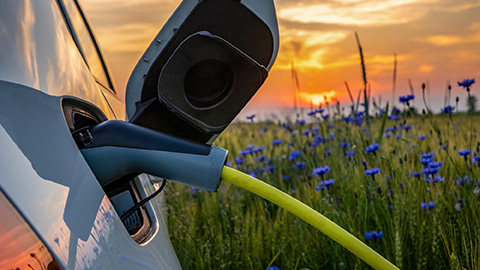
Over hundreds of miles, I shared the highway with plenty of EVs. And when I stopped, I talked with many people who told me they were taking their EVs all the way across the country to see the eclipse. I saw EV charging stations in new and unexpected places. I even saw an EV pull an Airstream camper into the campground next to me. The owners plugged the car into the park's charging station to recharge and powered the camper with solar.
Seeing all these signs of the EV transition made me feel the same way I do when I see the first signs of spring: excited, energized, and ready for the days ahead. Best of all, it was proof that our efforts to accelerate a clean energy future are working.
Proof of NREL's efforts are everywhere, too. Our sustainable transportation researchers are driving progress on clean energy solutions for entire sectors. We're delivering recommendations for charging electric vertical takeoff and landing aircraft and insights into the cost-competitiveness of zero-emissions trucks, optimizing autonomous, battery-electric rail car operations, and demonstrating zero-emissions supply chains. We're also working to perfect individual components, from replacing vehicle materials traditionally made from steel with recyclable carbon fiber composites to revolutionizing battery manufacturing.
Just like spring, the signs of the EV transition—and the impact of our efforts—are all around us. Here's to brighter days ahead.
Drive on,

Chris Gearhart
Director, NREL's Center for Integrated Mobility Sciences
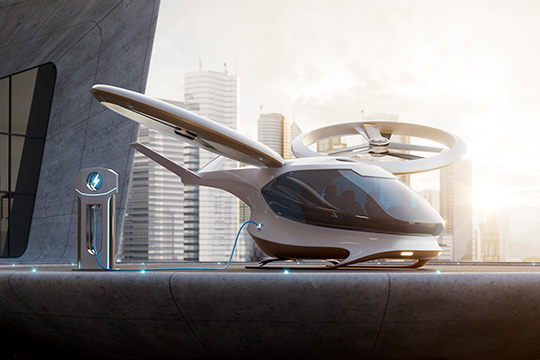
NREL Team Analyzes Charging Infrastructure Needs for Electric Aircraft
For a future with more electric aircraft, the electrical grid and aircraft charging infrastructure will need significantly greater capacity to manage the demand. An 18-person cross-lab NREL team estimated charging demand, distributed energy resource integration, and grid impacts and explored safety considerations across a variety of use cases. The resulting report provides the Federal Aviation Administration with analysis to inform policy for deploying electrified aircraft into the airspace system.
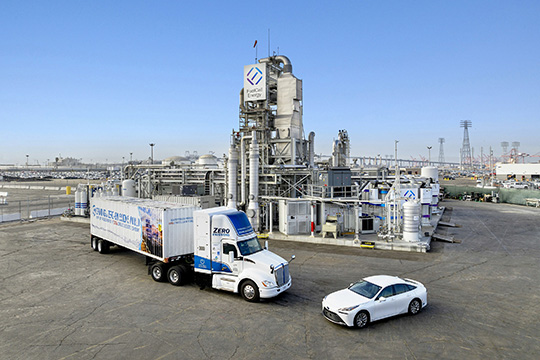
Project Demonstrates Clean Supply Chain of the Future, Using Today's Technology
For 12 months, zero-emissions vehicles (ZEVs) powered a clean demonstration supply chain—from battery-electric harbor cranes, which unloaded cargo containers from ships, to hydrogen-powered trucks, which drove goods from ports to storefronts across Southern California. Then NREL researchers quantified the findings. Now, the results from the Port of Los Angeles' Shore to Store project are in: A zero-tailpipe-emissions supply chain is possible, using today's technologies.
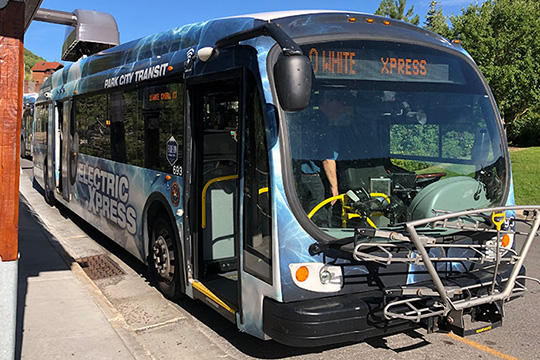
New Program Offers Free Technical Assistance To Develop Bus Fleet Electrification Plans
Managed by NREL and funded by the Joint Office of Energy and Transportation, the Clean Bus Planning Awards program provides American transit fleets with free technical assistance to create comprehensive and customized bus electrification plans. It aims to reduce the burden of electrification by helping fleet managers create a step-by-step plan to transition their buses and improve the chance of getting projects federally funded.
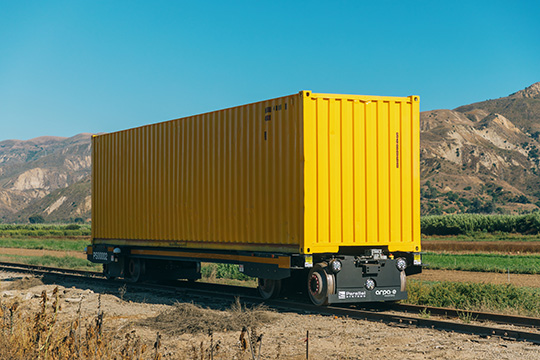
NREL Software Puts Clean Freight Rail Solutions on the Fast Track
Some of the most exciting innovations in transportation decarbonization will run on railroad tracks. That is certainly the case for the self-propelling, electric rail cars being built by Los Angeles startup Parallel Systems. NREL researchers are helping to propel this innovative technology using the Advanced Locomotive Technology and Rail Infrastructure Optimization System (ALTRIOS), the world's first comprehensive and open-source software to optimize rail decarbonization. ALTRIOS will optimize Parallel Systems' groundbreaking rail car operations to accelerate clean freight transportation at scale.
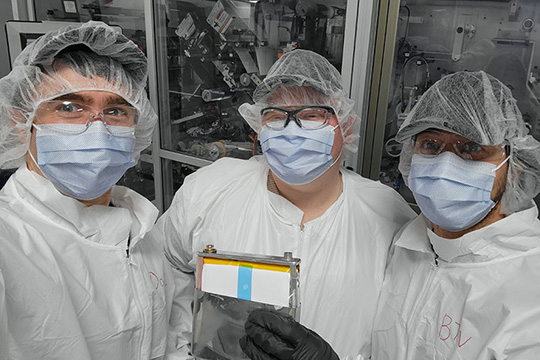
Laser-Patterning Process Poised To Revolutionize Battery Manufacturing
A recent battery manufacturing project—affectionately coined BatMan—has demonstrated a novel process using laser pulses to quickly and precisely modify and optimize electrode structures for manufacturing improvements. This technique unlocks battery performance improvements for fast charging and longer operational lifetimes. BatMan builds on NREL expertise using laser ablation, advanced computational models, and materials characterization to identify, implement, and validate microstructure enhancements.
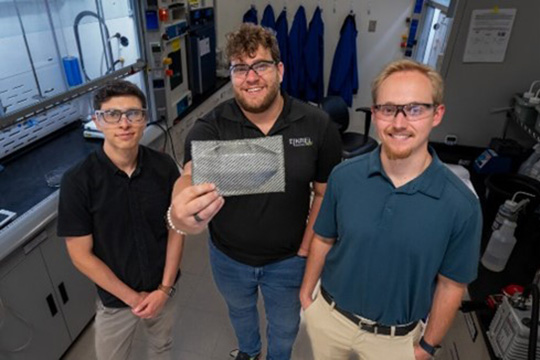
NREL's Recyclable-by-Design Carbon Fiber Composites Made Greener With Thermoforming
Carbon fiber composites made with NREL's plant-based epoxy are a lightweight, strong, and recyclable alternative to steel parts in vehicles. Researchers recently incorporated an improved recycling strategy called thermoforming that uses heat and molds to press the material into different shapes for subsequent lives. Combined with methanolysis, the process of chemically separating the filaments from the epoxy, recycling the material is becoming more cost efficient and energy efficient.
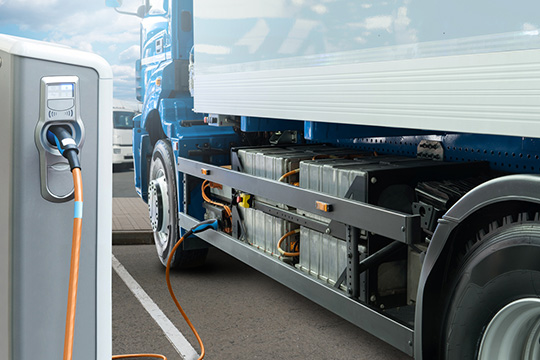
Study Examines Cost-Competitiveness of Zero-Emission Trucks
With continued improvements in vehicles and fuels, medium- and heavy-duty ZEVs—such as battery-electric vehicles and hydrogen fuel cell electric vehicles—are rapidly becoming commercially viable. Findings from a recent study exploring how their total cost of driving could evolve over time under different scenarios show that zero-emission trucks may reach total-cost-of-driving parity or better compared to diesel vehicles by 2035 in all market segments.
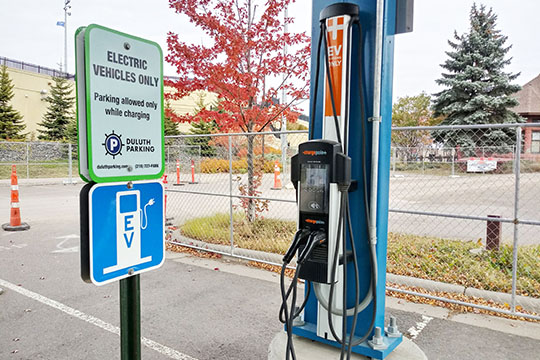
C-LEAP Identifies Electric Vehicle Charging Infrastructure Opportunities in Duluth, Minnesota
The Communities Local Energy Action Program (C-LEAP) partnered with stakeholders in Duluth, Minnesota, to analyze the EV charging environment and project the city's charging infrastructure needs heading into 2030. NREL helped Duluth identify a strategy for achieving its EV infrastructure goals now and into the future. Analysis included disadvantaged communities, where economic and accessibility factors affect EV adoption.
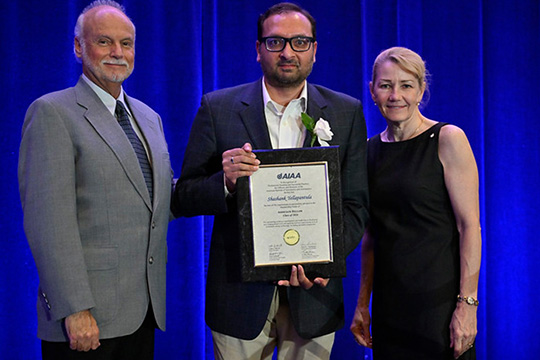
Computational Science Researcher Shashank Yellapantula Receives AIAA Fellow Designation
A senior staff scientist in the High-Performance Algorithms and Complex Fluids group within NREL's Computational Science Center, Shashank Yellapantula received an American Institute of Aeronautics and Astronautics (AIAA) fellow designation. The recognition is for contributions to the arts, sciences, or technology of aeronautics or astronautics. Yellapantula sees the AIAA fellowship as an opportunity to highlight sustainability—and the work NREL is doing—in aviation.
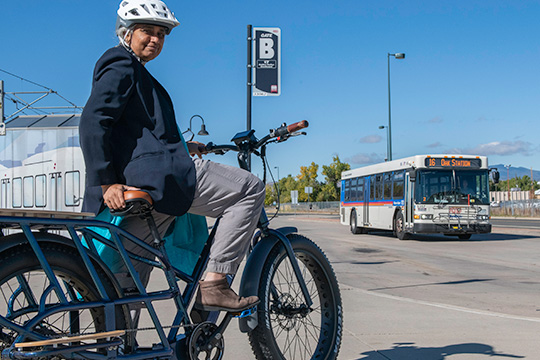
NREL Computational Mobility Scientist Honored for High-Impact Sustainable Transportation Research
NREL's K. Shankari received the Outstanding Early Career Scientist Award from CO-LABS for her research on computational mobility. The award recognizes remarkable initiative, collaboration, and other attributes—including the ability to inform and inspire others. Shankari's creation of NREL's Open Platform for Agile Trip Heuristics (NREL OpenPATH™), a groundbreaking open-source tool that empowers communities to collect and analyze their own transportation data by removing financial barriers, earned her this coveted award.
Get To Know Our Team: Cabell Hodge

A conversation with Cabell Hodge, who leads NREL's Analysis of Vehicle and Infrastructure Deployment group.
What does your work focus on?
I work on fleet electrification, charging station planning, and measurement and verification of novel charging solutions, like battery-boosted fast chargers. My team builds tools and processes to determine potential fleet candidates for alternative fuel vehicles, plan for charging infrastructure implementation, and analyze government policies to drive EV adoption.
What single mobility challenge would you say we need to prioritize in the next 5 years?
The next 5 years will be critical for the EV industry. There has been a lot of momentum from auto manufacturers pushing EV models, but we need to help ensure EV infrastructure is functional, available, and cost-effective. This is particularly important for people without dedicated garage parking who need to rely on community chargers.
Can you share a defining moment in your career?
In 2021, the Biden campaign contacted my team and me for consultation on planning the administration's clean transportation goals, including electrifying the federal fleet. So far in 2024, we have helped the federal fleet transition 23% of its light-duty acquisitions to EVs.
What project are you most proud of conducting?
My team has developed innovative tools that have been highly impactful in electrification of the federal fleet, including the U.S. Department of Energy's Zero-Emission Vehicle Planning and Charging (ZPAC) tool and EVI-LOCATE: Electric Vehicle Infrastructure-Locally Optimized Charging Assessment Tool and Estimator. These tools enable fleet managers to plan ZEV acquisitions and charging station deployments themselves, expanding fleet electrification work beyond the 500,000-vehicle federal fleet to the millions of fleet vehicles in the United States and beyond. Putting these tools in the hands of others will greatly increase the speed and efficiency of charging deployment and multiply the impact of our work.
Must Reads
To 2030 and Beyond: Mapping the Future of Sustainable Aviation Fuel
With demand for jet fuel expected to more than double by 2050, continued and accelerated efforts to decarbonize aviation are needed to curtail rising emissions and avert the worst outcomes of climate change. The Sustainable Aviation Fuel (SAF) Grand Challenge was established to meet these needs, but there is growing concern on whether enough biomass will be readily available to satisfy projected demand. The Challenge Ahead: A Critical Perspective on Meeting U.S. Growth Targets for Sustainable Aviation Fuel outlines the coordinated research, development, demonstration, and deployment efforts needed to realize these ambitious goals.
Quantifying the Impacts of Vehicle Electrification on the Nation's Grid
As the U.S. Environmental Protection Agency (EPA) finalizes proposed emissions standards for light-, medium-, and heavy-duty on-road vehicles, questions remain regarding the cost of the required charging infrastructure and associated upgrades to the nation's electric grid. A multidisciplinary team led by NREL conducted a U.S. Department of Energy multistate study to quantitatively assesses the investments necessary to enable the levels of vehicle electrification expected to be induced by these EPA regulations and to estimate the potential value of deferred investments in electric distribution infrastructure stemming from proactive vehicle-grid integration.
Uncovering Temperature-Induced Degradation in Battery Materials
A significant factor limiting battery lifetimes is structural degradation of the electrode material, which can be affected by the operating temperature of the battery itself. To learn how a recent study uncovered insights about battery electrode degradation, setting the stage for future optimized materials that can provide longer lifetimes and fast-charge capabilities, read Quantifying the Impact of Operating Temperature on Cracking in Battery Electrodes, Using Super-Resolution of Microscopy Images and Stereology, Energy Storage Materials.
Bio-Derived Resins Provide a New Life and Reduced Emissions for Energy Materials
Fiber-reinforced polymers can advance decarbonization by lightweighting transportation applications and enabling robust wind turbines. However, their current manufacture and inability to be reused contributes to growing material waste and continued greenhouse gas emissions. To learn how NREL researchers tackled this challenge head on, read Synthesis, Characterization, and Recycling of Bio-Derivable Polyester Covalently Adaptable Networks for Industrial Composite Applications, Matter.
Did You Know?
Concerns about carbon emissions are driving a shift toward SAF across the aviation industry. In a February episode of Transforming Energy: The NREL Podcast, hosts Kerrin Jeromin and Taylor Mankle highlight NREL's ultra-detailed SAF combustion simulation, which predicts how emerging SAFs will perform during takeoff, cruising, and landing. Learn how this "virtual jet engine" could help the industry avoid costly surprises as it works to get more SAF approved for commercial use.
In the News
Here's How–and Why–EVs and Solar Are Connected
Electrek quotes Shivam Sharda
EV owners are more likely to own solar panels as a source of energy to charge their vehicles. People might adopt both technologies after learning about them from people in their lives who already own rooftop solar or an EV. Bundling incentives could increase adoption of both technologies.
CO2 Emissions From Gas Cars Outweigh Electric, Even With Battery Manufacturing
USA Today quotes Matteo Muratori
Inaccurate claims online may overstate the emissions produced in the manufacturing of EV batteries. Plus, examining life cycle emissions of EVs shows that most EVs emit significantly less carbon dioxide than comparable gasoline-powered vehicles throughout their lifetimes. EVs could further lower their emissions if the electric grid were decarbonized.
The Next Frontier in EV Battery Recycling: Graphite
Grist quotes Matt Keyser
Graphite is a critical element in EV batteries. New export restrictions from China are leading to a push to boost U.S. domestic graphite sources, in part by recycling graphite from dead batteries. Researchers and companies are exploring recycling methods to meet graphite needs and make the supply chain more sustainable.
Why the Slowest EV Chargers May Be the Fastest Way To Get People Into EVs
Grist quotes Brennan Borlaug
A local electricity provider is funding the installation of Level 1 EV chargers in multifamily housing like apartment buildings and condos. Level 1 chargers use regular wall outlets and don't need expensive electrical upgrades, allowing building managers to install more chargers to serve people charging their cars overnight at home.
Green Ammonia Can Be a Clean Energy Source
Physics Today quotes Nicholas Thornburg
Ammonia is a compound partially made of hydrogen—the cleanest fuel available. But ammonia production itself produces a significant amount of greenhouse gas emissions. "Green ammonia," produced without the use of fossil resources, has the potential to be a significant energy source, such as in maritime shipping.
Share
Last Updated Nov. 10, 2025
